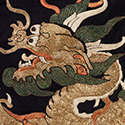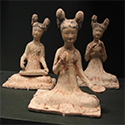|
|
| Show All 45 Results (Text Only) |
|
| The Artful Fabric of Collecting |
|
| Jordan Schnitzner Museum of Art, University of Oregon
|
Chinese textiles from the collection of Gertrude Bass Warner (1863-1951), who… was particularly drawn to silk textiles and the people who produced them, primarily the women in private households and commercial workshops. Techniques and patterns of weaving silk for Chinese robes are demonstrated on the site. It was only in the 17th century when the production of court orders began to overwhelm the imperial workshops that commercial workshops took over some of the production. In these commercial workshops, most of them located in the Jiangnan area, the center of China’s silk production, male weavers relegated women to the groundworks of silk production: the rearing of the silkworms and reeling the silk of the cocoons. Embroidery remained the domain of women. They were the master embroiderers who developed the art to its height in the Qing Dynasty (1644-1911). Their legacy can be admired in the textiles from the Warner collection.
Go to Museum Resource: https://glam.uoregon.edu/s/fabric-of-collecting/page/welcome | |
|
|
|
|
| Chinese Calligraphy |
|
| The Metropolitan Museum of Art
|
An overview of the development of calligraphy in China: "Calligraphy, or the art of writing, was the visual art form prized above all others in traditional China. The genres of painting and calligraphy emerged simultaneously, sharing identical tools—namely, brush and ink. Yet calligraphy was revered as a fine art long before painting; indeed, it was not until the Song dynasty, when painting became closely allied with calligraphy in aim, form, and technique, that painting shed its status as mere craft and joined the higher ranks of the fine arts. With images of 16 paintings from the Song, Ming, and Qing dynasties and two related objects.
Go to Museum Resource: http://www.metmuseum.org/toah/hd/chcl/hd_chcl.htm | |
|
|
| Chinese Cloisonné |
|
| The Metropolitan Museum of Art
|
A brief introduction to the development of cloisonné in China during the early 14th to 15th century, as well as to the cloisonné technique. With 2 related artworks.
Go to Museum Resource: http://www.metmuseum.org/toah/hd/clos/hd_clos.htm | |
|
|
| Chinese Handscrolls |
|
| The Metropolitan Museum of Art
|
An overview of the Chinese handscroll format: "A significant difference between Eastern and Western painting lies in the format. Unlike Western paintings, which are hung on walls and continuously visible to the eye, most Chinese paintings are not meant to be on constant view but are brought out to be seen only from time to time. This occasional viewing has everything to do with format." With images of 18 paintings from the Tang, Song, Yuan, Ming, and Qing dynasties.
Go to Museum Resource: http://www.metmuseum.org/toah/hd/chhs/hd_chhs.htm | |
|
|
| Chinese Landscape Painting During the Song Dynasty |
|
| Princeton University Art Museum
|
“Landscape painting dominated Chinese painting beginning in the tenth century. The word for landscape painting in Chinese, shan shui hua, literally means “mountain (shan) water (shui) painting (hua).” Mountains are hard and unyielding; water is soft and fluid. These opposites are an example of the concept of yin and yang—the idea that everything in nature is composed of complementary but opposing forces that interact and change. Complementary opposites is one of several core cultural concepts of the Song dynasty that are encapsulated in many of the period’s landscape paintings.”
Go to Museum Resource: https://artmuseum.princeton.edu/asian-art/china/resources/landscape-painting/ | |
|
|
| Chinese Painting |
|
| The Metropolitan Museum of Art
|
An introduction to Chinese painting: "This is the aim of the traditional Chinese painter: to capture not only the outer appearance of a subject but its inner essence as well—its energy, life force, spirit." With images of 19 paintings from the Tang, Song, Yuan, and Ming dynasties.
Go to Museum Resource: http://www.metmuseum.org/toah/hd/chin/hd_chin.htm | |
|
|
|
| Show All 45 Results (Text Only) |









